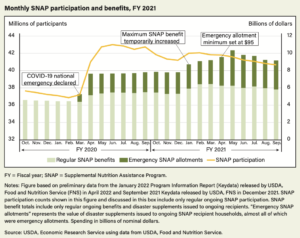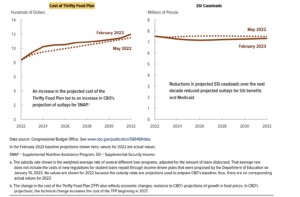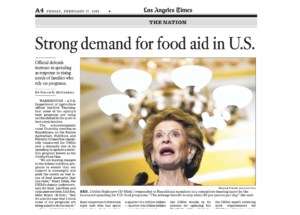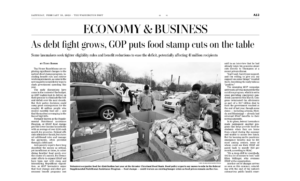The Agriculture Department has finalized some revisions to two major farm commodity programs, including rules for adding new base acres, but signup for the programs won’t be scheduled until after…
Farm Bill Budget, SNAP in Focus at Senate Ag Committee Nutrition Hearing
On Thursday, the Senate Ag Committee held a hearing on USDA nutrition programs in the next Farm Bill.

In her opening statement, Committee Chairwoman Debbie Stabenow (D., Mich.) indicated that, “SNAP [The Supplemental Nutrition Assistance Program] is a countercyclical support. Just as we see spending in farm programs increase when commodity prices are low, spending in SNAP increases during economic downturns. As the economy improves and families no longer need assistance, SNAP spending naturally decreases. And it is important to note that when SNAP spending increases, it does not take money away from farm programs. We witnessed the program expand and contract based on need during and after the Great Recession, and most recently during the pandemic.”


“Since the last farm bill, the cost of the largest of these programs, [SNAP], has grown by more than 94 percent, from $65 billion annually in 2018 to an expected $127 billion in 2023.”

More narrowly, the CBO update stated that, “Supplemental Nutrition Assistance Program. CBO increased its estimate of outlays for SNAP by $8 billion (or 6 percent) for 2023 and by $93 billion (or 8 percent) over the 2023–2032 period for technical reasons—two in particular. First, projected SNAP enrollment is higher than it was in the May 2022 baseline. Second, CBO increased its projections of the cost of the Thrifty Food Plan (TFP) in 2027 and 2032, anticipating that reevaluations of the TFP, which occur every five years, would result in increases in costs. (The TFP is a basket of foods identified by the Department of Agriculture that would provide a nutritious diet for a household of a particular size; the cost of the TFP is used to determine SNAP benefit levels.”

Ranking Member Boozman indicated that, “The pandemic and inflation drove some of these cost increases but let there be no doubt that the largest driver was a decision by the leadership of the Food, Nutrition, and Consumer Services (FNCS) mission area to abandon 40 years of precedent and increase SNAP benefits by 21% to record-high levels, levels that are unsustainable. Some will cynically point to provisions to update the Thrifty Food Plan in the 2018 Farm Bill as the basis for USDA’s action, but Congress never agreed to permit a quarter of a trillion-dollar spending increase.”
Ranking Member Boozman added that, “When one program constitutes more than 80 percent of the spending in the next farm bill, and thereby effectively crowds out the ability to make crucial investments in every other title, is there really any room left for farmers in the traditional farm bill coalition?”
In her prepared testimony at Thursday’s hearing, USDA’s Deputy Under Secretary for Food, Nutrition, and Consumer Services, Stacy Dean, stated that, “In 2021, in the midst of the pandemic and economic turmoil that closed schools and left millions out of work and struggling to put food on the table, USDA conducted a reevaluation of the Thrifty Food Plan (TFP), which serves as the basis for determining the value of SNAP benefits. As directed by Congress in the 2018 Farm Bill, USDA used the latest available data and an evidence-based process to update the Plan to reflect the cost of a practical, cost-effective, nutritious diet in today’s market.”

Nolan D. McCaskill reported in Friday’s Los Angeles Times that, “A U.S. Department of Agriculture official testified Thursday that some of the agency’s food programs are being overburdened in the push to feed needy families.
The acknowledgment came Thursday morning as Republicans on the Senate Agriculture, Nutrition, and Forestry Committee repeatedly hammered the USDA over a dramatic rise in its spending to update a nutrition program known as the Thrifty Food Plan.
McCaskill explained that, “[Stacy Dean] said the 2018 farm bill required the USDA to reevaluate ‘and essentially update‘ its cost estimate for a budget-conscious healthful diet. The evaluation looked at four areas, she said: current prices, new dietary guidelines, nutrients in food and what types of foods Americans buy.
“It ‘resulted in the first increase in real purchasing power benefit in over 45 years, but that amount increased 40 cents per person per meal,’ she continued. ‘Of course, in aggregate, it was a significant increase, but it also very clearly puts healthy food within reach for tens of millions of Americans.’
“Boozman countered that the CBO had projected no cost increase at all, pointing out why Republicans were so concerned by the surprise $250 billion in spending. Some of his GOP colleagues on the committee asked why the USDA wasn’t enforcing work requirements for SNAP beneficiaries, something Congress temporarily suspended until the public health emergency is lifted.”
Meanwhile, Tony Romm reported in Saturday’s Washington Post that, “Top House Republicans are exploring significant changes to the nation’s food stamps program, including benefit cuts and stricter work requirements, as some in the new majority scramble for ways to slash government spending this year.
“The early discussions have come in the context of the budget, as GOP leaders look to deliver on their promise to eliminate the federal deficit over the next decade. But their policy decisions could carry great consequences for the roughly 41 million people who receive monthly food aid — and find themselves scrounging in the face of high bills.”

The Post article noted that, “The emerging GOP campaign arrives at a pivotal moment for the nutrition program, which is set to cease providing emergency pandemic payments this March. Congress terminated the allotments as part of a $1.7 trillion deal to fund the government reached at the end of last year, though some states — including Arizona, Florida and Mississippi — already had returned SNAP benefits to their normal amounts.”
Romm pointed out that, “In many ways, the emerging fight is a familiar one in Washington. Five years ago, a GOP House and Democratic Senate similarly forged ahead on a renewal of the farm bill — and found themselves sparring over federal nutrition programs.”





